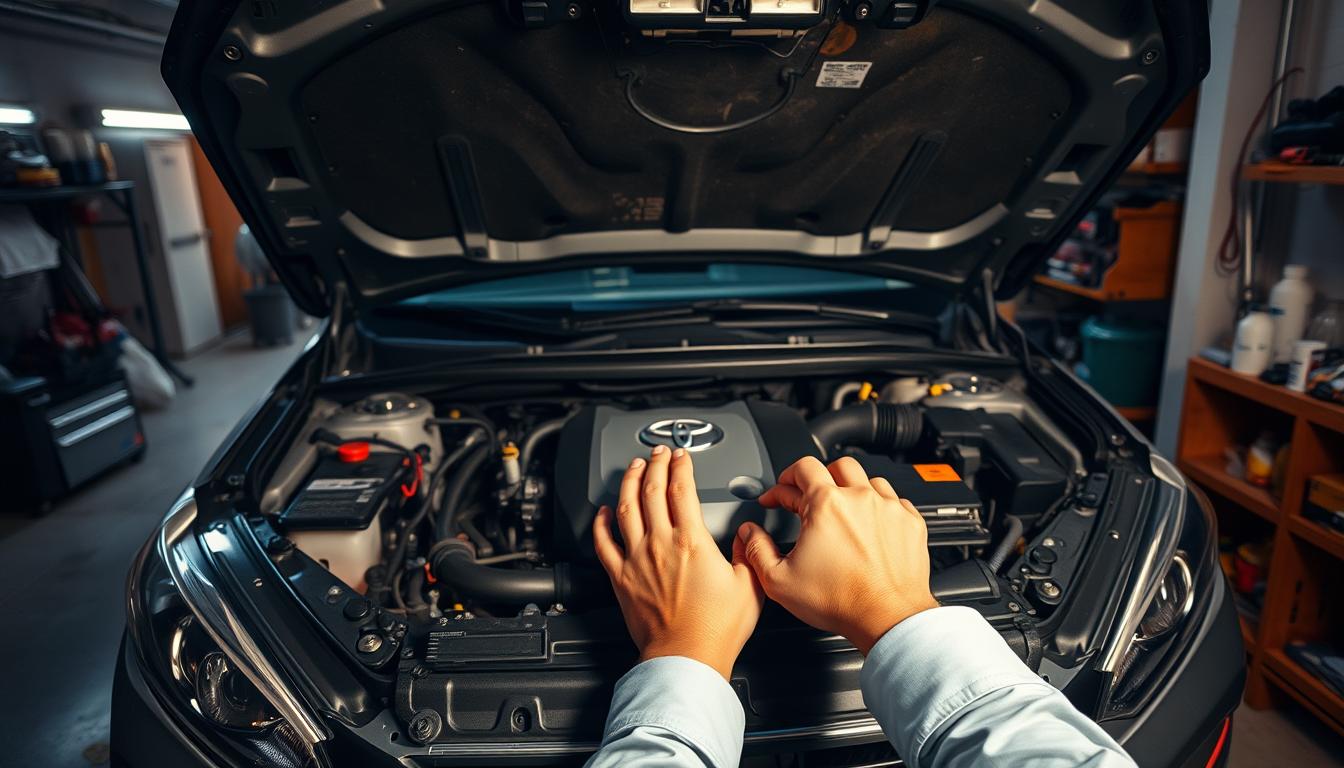Are you a Toyota owner with an oil leak? It’s important to fix it fast to avoid engine damage. Ignoring it can lead to expensive repairs.
Fortunately, there are DIY tips to help you fix it quickly. Using a stop-leak additive is a simple way to stop the leak. But, you must find and fix the main cause to avoid more damage.
In this article, we’ll show you how to diagnose and repair a Toyota oil leak. We’ll walk you through the steps and share tips to make the job easier.
Why Toyota Oil Leaks Happen
It’s important to know why Toyota oil leaks happen. This helps keep your engine healthy. If not fixed quickly, oil leaks can damage your engine a lot.
Common Causes of Oil Leakage in Toyota Engines
There are a few reasons why Toyota engines leak oil. Worn or cracked engine gaskets, oil pan leaks, valve cover leaks, and old oil seals are common causes. These problems usually come from engine parts wearing out over time.
How Age and Mileage Affect Gasket Integrity
As your Toyota gets older and goes more miles, its gaskets can weaken. High mileage can make gaskets break down, causing leaks. Keeping up with regular maintenance helps these parts last longer.
Impact on Different Toyota Models
Age and mileage affect gaskets differently in various Toyota models. Some models might leak oil more because of their design or engine type. Knowing this helps Toyota owners prevent leaks.
Identifying a Toyota Oil Leak: Key Symptoms
Knowing the signs of a Toyota oil leak is key to quick action and avoiding big engine problems. If not fixed fast, an oil leak can cause serious damage.
There are several key symptoms to look out for when identifying a possible oil leak in your Toyota vehicle.
Visual Signs: Oil Spots and Engine Residue
One clear sign of an oil leak is dark puddles or spots under your car. You might also see oil residue on the engine or nearby parts. Checking your garage or driveway often can help spot a leak early.
Performance Indicators: Smoke, Smell, and Power Loss
If your Toyota is leaking oil, you might see blue smoke from the tailpipe. A burnt oil smell is another sign. An oil leak can also make your engine run less well or lose power.
Dashboard Warnings and Oil Level Changes
Modern Toyotas have smart dashboard warning systems. Watch for the oil pressure warning light, as it can mean a leak or low oil. Also, check your oil level often; a sudden drop means a leak.
| Symptom | Description |
|---|---|
| Dark Puddles | Oil spots under the vehicle |
| Blue Smoke | Smoke from the tailpipe indicating oil is burning |
| Burnt Oil Smell | A strong smell of burnt oil from the engine area |
| Dashboard Warnings | Oil pressure warning light on the dashboard |
Essential Tools and Materials for Toyota Oil Leak Repair
Before starting Toyota oil leak repair, you need the right tools and parts. The right equipment makes the job easier and helps find and fix the leak accurately.
Diagnostic Tools: Flashlights, UV Dye, and Pressure Testers
Diagnostic tools are key to finding the oil leak source. A flashlight helps light up dark spots under the hood. UV dye is added to the oil and glows under UV light, showing leaks. Pressure testers pressurize the oil system, making leaks easier to spot.
- Flashlights for better visibility
- UV dye kits for precise leak detection
- Pressure testers to simulate operating conditions
Repair Supplies: Gaskets, Sealants, and Fluids
After finding the leak, gather the needed repair supplies. This includes gaskets and sealants for your Toyota, and the right engine oil. Using the correct supplies ensures a strong fix and prevents more damage.
- Gaskets and seals compatible with your Toyota model
- High-quality sealants for a long-lasting repair
- The correct viscosity engine oil
Safety Equipment: Gloves, Goggles, and Jack Stands
Safety is a must. Gloves protect your hands, and goggles keep your eyes safe from debris. Jack stands make working under the car safe and stable.
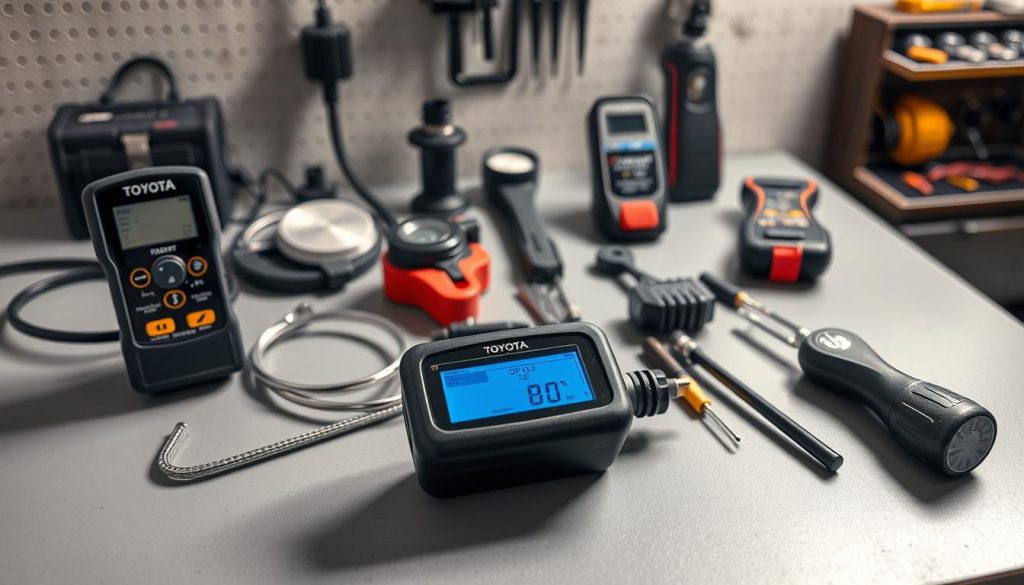
- Durable gloves for hand protection
- Safety goggles for eye protection
- Sturdy jack stands for vehicle support
With these tools and materials, you’re ready to diagnose and fix Toyota oil leaks efficiently and safely.
Preparing Your Toyota for Oil Leak Diagnosis
Starting to find an oil leak in your Toyota means getting ready first. This step is key to spotting the leak’s source and fixing it right.
Setting Up a Safe Work Environment
First, make sure your work area is safe and has good air flow. Park your Toyota on a flat surface and lock the brakes. Wear gloves and safety glasses to stay safe.
Engine Cleaning Techniques for Better Visibility
Cleaning the engine is vital to see oil leaks. Use a degreaser to wipe away dirt and grime.
Degreaser Selection and Application
Pick a degreaser that won’t harm your engine. Follow the maker’s guide to use it, staying away from sensitive parts.
| Degreaser Type | Application | Safety Precautions |
|---|---|---|
| Solvent-based | Spray on dirty areas, let sit, then rinse | Wear gloves, avoid skin contact |
| Water-based | Apply with a brush, rinse with water | Eye protection recommended |
By doing these steps, you’re ready to find and fix oil leaks in your Toyota. This makes the repair safer and more effective.
Step-by-Step Toyota Oil Leak Diagnosis
Oil leaks in Toyota vehicles can be found using UV dye and pressure tests. Finding the leak is the first step to fix it.
The UV Dye Method: Application and Detection
The UV dye method is a great way to find oil leaks. You add UV dye to the engine oil. Then, a UV light shows where the leak is because the dye glows.
Steps to Use UV Dye:
- Add the UV dye to the engine oil.
- Run the engine for a few minutes to circulate the dye.
- Use a UV light to inspect the engine and identify the leak.

Pressure Testing the Oil System Safely
Pressure testing is another way to find oil leaks. It pressurizes the engine’s oil system to show leaks. But, it needs careful handling and the right tools to avoid engine damage.
| Pressure Testing Steps | Safety Precautions |
|---|---|
| 1. Connect a pressure tester to the oil dipstick tube. | Ensure the engine is cool before starting. |
| 2. Pressurize the system according to the manufacturer’s instructions. | Wear protective gear, including gloves and goggles. |
| 3. Inspect the engine for leaks. | Be cautious of high pressure; do not exceed recommended levels. |
Visual Inspection: What to Look For and Where
A visual check is easy to spot oil leaks. Look for oil signs around the oil pan gasket, valve cover gasket, and main seals.
Key areas to inspect:
- Oil pan and gasket
- Valve cover gasket
- Main seals (front and rear)
- Timing cover
By following these steps and using the right methods, you can find oil leaks in your Toyota. Whether it’s UV dye, pressure testing, or a visual check, finding the leak is the first step to fix it.
Common Toyota Oil Leak Locations and Their Symptoms
Knowing where oil leaks happen in your Toyota is key to fixing them. Oil leaks can occur in many engine parts. Finding the exact spot is essential for a good repair.
Valve Cover Gasket Leaks: Identification and Assessment
The valve cover gasket is a common leak spot in Toyotas. You might see oil spots on the ground or engine. A burning smell can also happen if oil hits hot parts.
To spot a valve cover gasket leak, look for oil seepage or drips on the valve cover.
Oil Pan Gasket Failures: Signs and Severity
Oil pan gasket failures can cause big oil leaks. You might see oil puddles under the car or notice low oil levels. These problems need quick fixing to avoid engine damage.
Main Seal Leaks: Front and Rear Indicators
Main seal leaks, both front and rear, can let oil leak from the engine. Look for oil on the transmission or bellhousing for rear leaks. For front leaks, oil might be on the engine’s front.
These leaks are harder to find and fix.
Timing Cover Leaks: Recognition Patterns
Timing cover leaks are also common. Oil from the timing cover can drip on the ground or other engine parts. Check the timing cover and around it for oil leaks.
Knowing about these leak spots and their signs helps Toyota owners fix oil leaks. This can save time and money on repairs.
How to Fix Valve Cover Gasket Leaks in Toyota Engines
Fixing a valve cover gasket leak in Toyota engines is doable at home. You’ll need basic tools and some mechanical know-how. The valve cover gasket keeps oil from leaking. It can wear out over time, causing leaks.
Step-by-Step Removal Process
To fix it, start by removing the valve cover. First, disconnect the negative battery cable to avoid engine starts. Then, take off parts like the air intake duct or ignition coils that block access.
Loosen and remove the bolts with a socket wrench. Carefully pry off the valve cover to avoid damaging the surfaces.
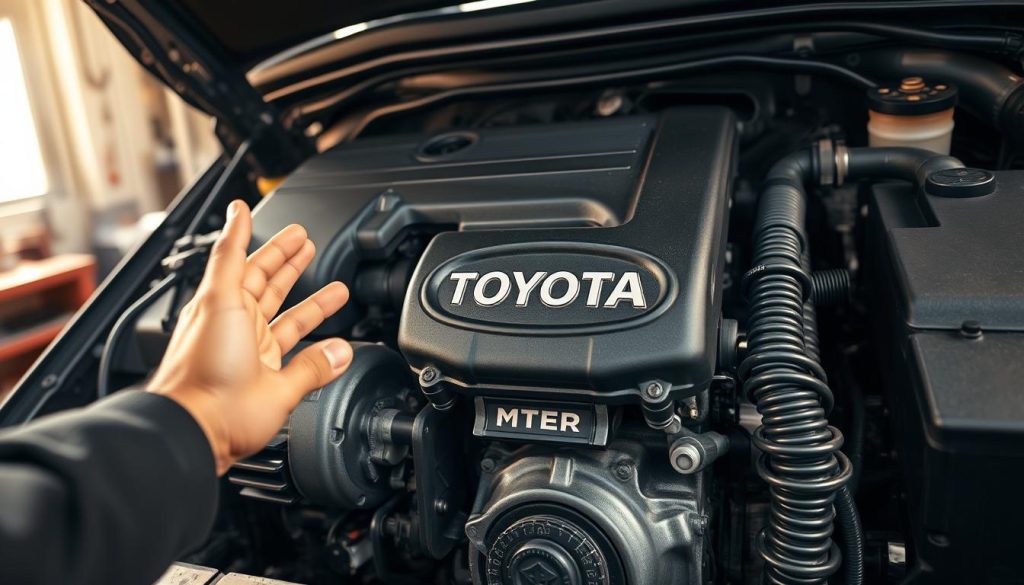
Gasket Replacement and Surface Preparation
After removing the valve cover, check the gasket for wear or damage. Clean the valve cover and engine head well to ensure a good seal. Use a scraper or solvent to remove old gasket material and residue.
Put on a new valve cover gasket, making sure it’s aligned right. Apply gasket sealant if the manufacturer suggests it.
Proper Torque Specifications by Model
When putting the valve cover back on, follow the right torque for your Toyota. Tightening too much can damage the threads or crush the gasket. Tightening too little can cause leaks.
Camry, Corolla, and RAV4 Specifications
For Camry, Corolla, and RAV4 models, use these torque specs:
- Camry: 8-10 Nm (70-90 in-lbs)
- Corolla: 7-9 Nm (60-80 in-lbs)
- RAV4: 9-11 Nm (80-100 in-lbs)
Always check your repair manual for the best and most accurate info for your model.
Repairing Toyota Oil Pan Gasket Leaks
Oil pan gasket leaks are common in Toyota vehicles. But fixing them is not hard. Just follow a few steps to do it right.
Safely Accessing the Oil Pan
To fix the oil pan gasket, first, you need to get to the oil pan. Raise your Toyota on a hydraulic jack and use jack stands for safety. Make sure the car is on a level surface and the parking brake is on.

Removing and Replacing the Damaged Gasket
After getting to the oil pan, drain the oil and take off the oil pan to check and replace the gasket. Clean the surfaces well before putting in a new gasket.
Reinstallation Best Practices and Common Mistakes
When putting the oil pan back, make sure the gasket fits right and tighten the pan in the right order. Avoid over-tightening and not aligning the gasket properly.
| Step | Description | Tips |
|---|---|---|
| 1 | Raise the vehicle | Use jack stands for safety |
| 2 | Drain the oil | Use a suitable container |
| 3 | Remove the oil pan | Be careful not to damage the pan or gasket |
| 4 | Replace the gasket | Clean the mating surfaces thoroughly |
Tackling Toyota Timing Cover Oil Leaks
Figuring out why your Toyota’s timing cover leaks can be tricky. But knowing the reasons and signs is key to fixing it right. If you don’t fix it fast, it could really hurt your engine. So, it’s important for Toyota owners to know how to spot and fix these leaks.
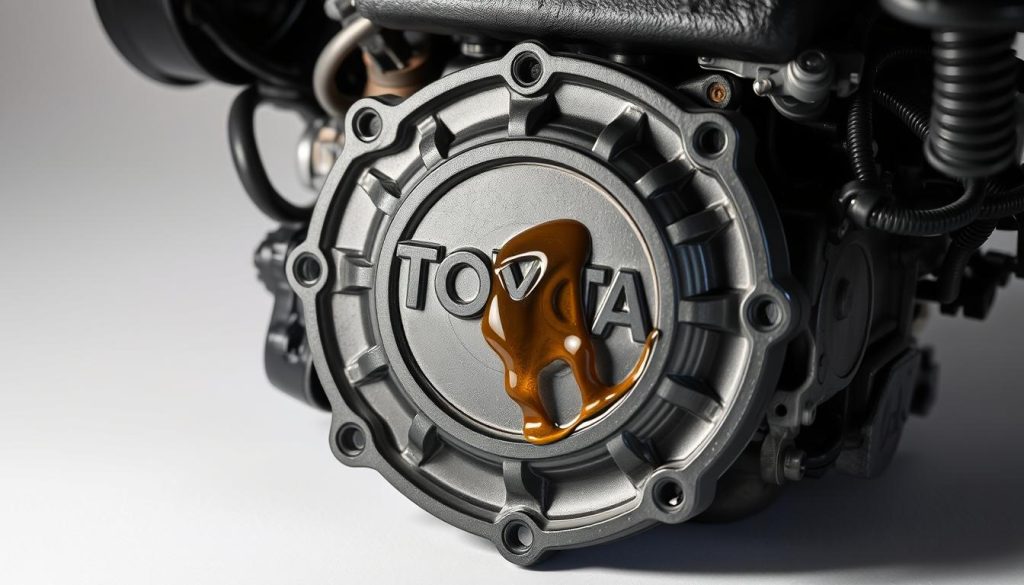
Identifying Timing Cover Leak Patterns
Start by looking for where the oil is leaking. Check the timing cover area for oil drips or stains. A UV dye can help find the exact leak spot.
Replacement Process Overview and Timeline
Replacing the timing cover gasket or seal needs careful steps. First, take off the timing cover. Then, check for damage and swap out the gasket or seal. The time it takes can vary, but it usually takes a few hours.
Special Considerations for 4-Cylinder vs. V6 Engines
Replacing the timing cover can be different for 4-cylinder and V6 engines. V6 engines have a more complex design, making the job harder. Knowing these differences is important for a good repair.
As “A well-maintained engine is the heart of a reliable vehicle,” fixing timing cover oil leaks quickly is critical. By spotting the leaks, knowing how to replace parts, and considering your engine type, you can fix this common problem.
Addressing Toyota Oil Leak from Main Seals
Fixing oil leaks from main seals in Toyota engines needs careful thought. Main seal leaks are tough and might need a pro, based on your DIY skills. It’s key to know how hard it is and what skills you need before starting.
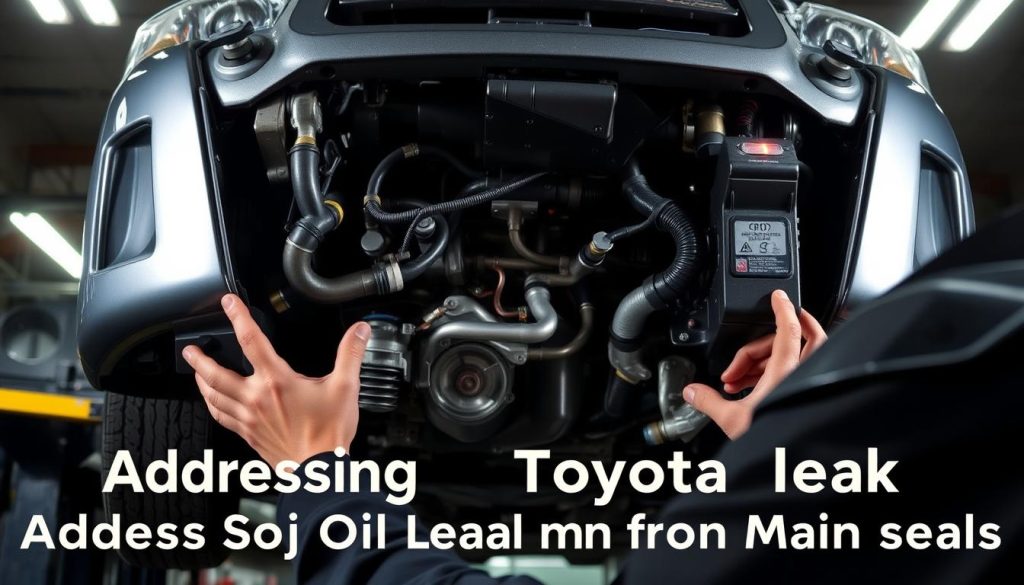
Difficulty Assessment and Skill Requirements
Main seal leaks are a big deal because they can harm your engine if not fixed fast. The hard part is getting to the seals, which means taking apart a lot of the engine. Before you start, think about your DIY experience, if you have the right tools, and if you’re okay with complex tasks.
Basic Repair Steps for the Determined DIYer
If you’re set on doing it yourself, here’s what you need to do:
- Find out where the leak is by using UV dye or a pressure test.
- Take out the transmission or engine parts to get to the main seal.
- Get the old seal out and clean the area where it was.
- Put in a new main seal, making sure it’s right and fits well.
- Put back the engine or transmission parts.
When to Consider Professional Help
If you’re not sure or don’t have experience, it’s best to get a pro. Replacing main seals is tricky, and doing it wrong can cause more problems.
Tools and Time Investment Analysis
You’ll need various tools, like seal pullers and special installation tools, for the job. It will take a lot of time, possibly hours or days, depending on how hard it is and your skill level.
Quick Fixes for Minor Toyota Oil Leaks
Minor oil leaks in Toyota vehicles can often be fixed with simple solutions. These fixes are temporary but can help until a more lasting repair is done.
Oil Stop Leak Products: Effectiveness and Limitations
Oil stop leak products can be a quick fix for minor leaks. They work by making seals and gaskets new again, which might stop the leak. But, how well they work depends on the leak’s size and where it is.
- Pros: Easy to use, can be effective for small leaks.
- Cons: May not work for larger leaks, can contaminate oil.
Tightening Loose Components: What’s Safe to Adjust
Sometimes, oil leaks come from loose parts. Tightening these can fix the problem. But, it’s important to know which parts to tighten and not to overdo it, which can harm the car.
- Check the oil drain plug and tighten if necessary.
- Inspect the oil filter and ensure it’s properly secured.
Temporary Sealing Solutions for Emergency Situations
In emergencies, temporary fixes can help. Products like sealants or gasket makers can stop minor leaks. But, they’re not meant to last and should be used carefully.
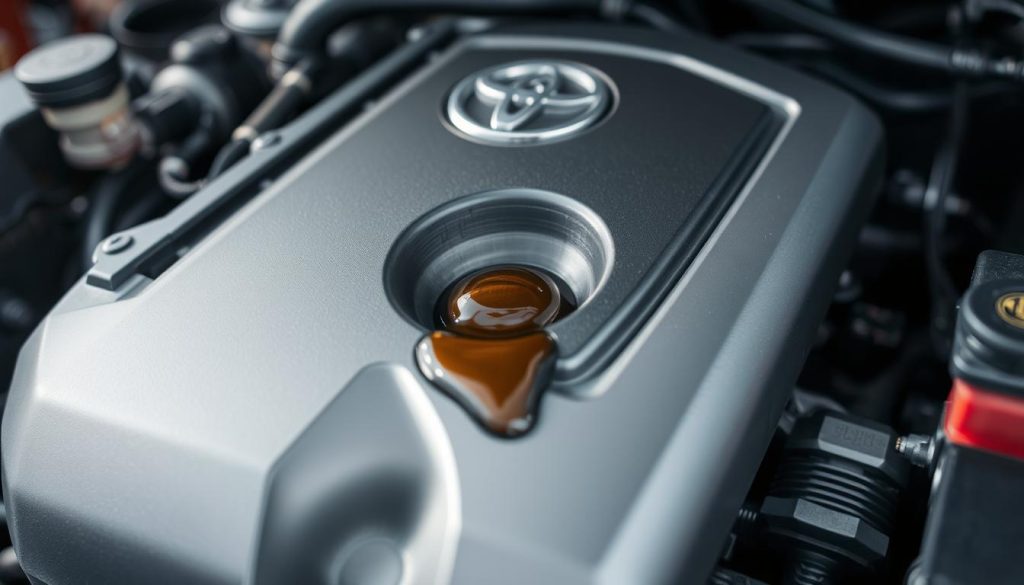
Knowing these quick fixes can help Toyota owners deal with minor oil leaks. But, it’s key to get a proper repair to avoid more problems.
Preventing Future Toyota Oil Leaks
To stop oil leaks in your Toyota, mix regular upkeep, top-notch parts, and smart driving. Knowing why oil leaks happen and acting early can lower the chance of future leaks.
Maintenance Schedules That Reduce Leak Risk
Keeping up with maintenance is key to avoiding oil leaks. This means regular oil changes, checking gaskets and seals, and replacing old parts on time. Regular oil changes keep your engine healthy by keeping it well-lubricated, which lowers leak risk.
Selecting Quality Oil and Filters for Your Toyota
Choosing high-quality oil and filters is essential for your Toyota’s engine life. Good oil stays thick in different temperatures, easing seal stress. Also, a quality filter keeps out dirt, protecting engine parts.
Driving Habits That Extend Gasket Life
Your driving habits affect your Toyota’s engine health. Steer clear of extreme temperatures, don’t rev too high, and warm up slowly. These actions help your gaskets and seals last longer.
Temperature Management and Warm-Up Procedures
Right temperature management means avoiding harsh driving and warming up your engine right. This eases engine stress and prevents leaks.
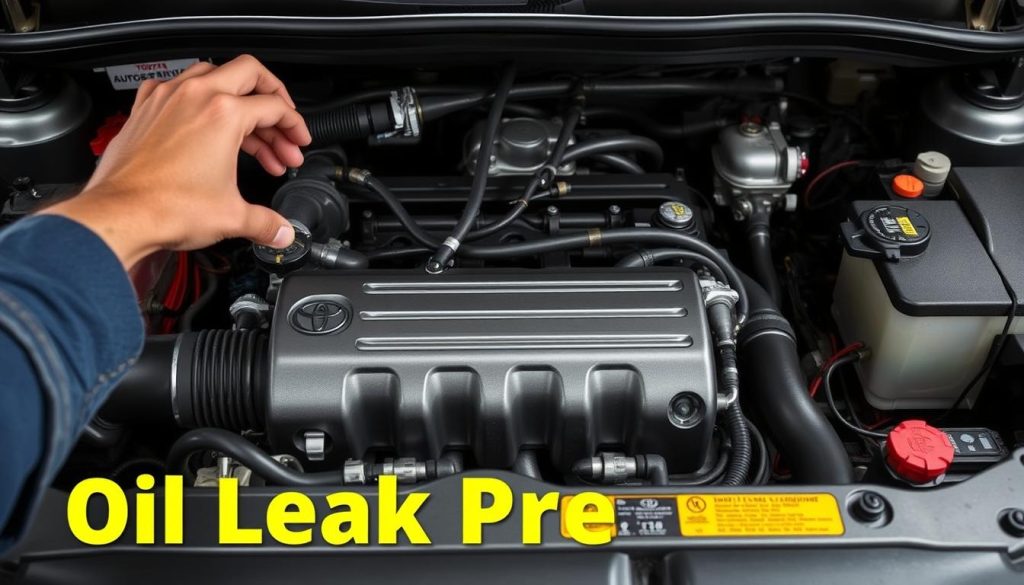
When DIY Won’t Cut It: Professional Toyota Oil Leak Repair
Complex oil leaks in Toyota vehicles can be hard to fix without the right tools and knowledge. DIY fixes might work for small problems, but some leaks need a pro mechanic’s touch.
Complex Leak Scenarios Beyond Home Garage Capability
Some oil leaks are too tricky for a home garage. Leaks from the engine’s main seals or timing cover gaskets need special tools and skills. A study by the Automotive Research Association of India found that about 30% of engine repairs for oil leaks need a pro’s help.
“The complexity of modern engines demands a higher level of diagnostic capability, making professional repair services indispensable for many car owners.” –
Signs the Job Requires Specialized Equipment
If you see these signs, it’s time to call a pro: oil keeps leaking after DIY fixes, can’t find where it’s coming from, or if it’s causing other engine problems. Tools like UV dye kits and pressure testers are needed for complex leaks.
| Signs | Description |
|---|---|
| Oil Leakage Persistence | Leak continues despite DIY repairs |
| Unidentified Source | Unable to locate the source of the leak |
| Performance Issues | Leak is accompanied by engine performance problems |
Finding and Vetting a Trustworthy Toyota Specialist
To find a reliable Toyota specialist, ask friends or family, check online reviews, and look for ASE (Automotive Service Excellence) certifications. Make sure they know your Toyota model and the repair you need.

Knowing when to ask for professional help and finding a trustworthy specialist ensures your Toyota gets the right care for oil leak repairs.
Cost Comparison: DIY vs. Professional Toyota Oil Leak Repair
It’s important to know the cost differences between DIY and professional Toyota oil leak repairs. This helps you make a smart choice.
For a DIY fix, you need to consider the costs. Here are some typical expenses:
Typical DIY Repair Expenses Breakdown
- Gaskets and sealants: $50-$200
- Diagnostic tools: $20-$100
- Fluids and other materials: $50-$150
The total DIY repair cost can be between $120 and $450. This depends on how complex the leak is.
Professional Repair Costs by Leak Type and Model
Professional repairs are often pricier. Labor, diagnostic fees, and parts can quickly add up. For instance, fixing a valve cover gasket leak might cost $300 to $800. An oil pan gasket leak repair can be $400 to $1,200.
Long-term Financial Considerations and Value Analysis
DIY repairs might seem cheaper at first. But, professional repairs often come with warranties. This can save you money later on. As “a stitch in time saves nine”, a proper repair can avoid future leaks and big damages. A well-known mechanic once said:
“A well-done repair is an investment, not an expense.”
So, whether to DIY or get a professional repair depends on your budget, skills, and what you value most.
Conclusion
Fixing a Toyota oil leak is key to keeping your car running well. We’ve looked at why leaks happen, how to spot them, and how to fix them yourself.
Spotting the leak is the first step. You can use UV dye or pressure tests to find where it’s coming from. Then, you can fix or replace the part that’s leaking, like a gasket or seal.
By following this guide, you can avoid expensive repairs and keep your Toyota in top shape. Regular checks on your oil and engine can help stop leaks before they start.
Whether you’re new to DIY car repairs or experienced, this guide has helped you understand how to handle oil leaks. Stay on top of maintenance, and your Toyota will stay reliable.
FAQ
What are the common causes of Toyota oil leaks?
Toyota oil leaks often come from worn-out gaskets or damaged seals. Cracked engine parts can also cause leaks. Over time, age and mileage can weaken gaskets, leading to leaks.
How do I identify a Toyota oil leak?
Look for oil spots and engine residue. Check for smoke, smell, and power loss. Dashboard warnings and changes in oil level can also signal a leak.
What tools and materials do I need to diagnose and repair a Toyota oil leak?
You’ll need tools like flashlights and UV dye. Also, get pressure testers and repair supplies like gaskets and sealants. Don’t forget safety gear like gloves and goggles.
Can I use stop leak products to fix a Toyota oil leak?
Stop leak products can work for small leaks. But, they’re not a permanent fix. It’s key to find and fix the leak’s source for a lasting solution.
How can I prevent future Toyota oil leaks?
Regular maintenance and using quality oil and filters help. Good driving habits also play a role. Sticking to the recommended maintenance schedule is important.
When should I seek professional help for a Toyota oil leak?
If the leak is complex or you’re unsure, get a Toyota specialist. Look for extensive damage or if you need special equipment.
What are the costs associated with DIY versus professional Toyota oil leak repair?
DIY costs include tool and material expenses, plus stop leak products. Professional repair costs vary by leak type and model. They may include labor and parts.
How do I diagnose a Toyota oil leak using the UV dye method?
Apply UV dye to the engine oil and use a UV light to find leaks. This method helps pinpoint the leak’s source.
What are the common locations of oil leaks in Toyotas?
Leaks often occur at the valve cover gasket, oil pan gasket, main seals, and timing cover. Each spot has its own symptoms and repair methods.
Can I fix a Toyota oil leak from the main seals on my own?
Repairing main seal leaks is tough and needs a lot of DIY skills. If unsure, it’s safer to get professional help to avoid more damage.
